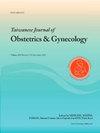双胎妊娠先天性膈疝的出宫产内治疗(EXIT)策略:1例报告并文献复习
IF 2.2
4区 医学
Q2 OBSTETRICS & GYNECOLOGY
引用次数: 0
摘要
目的生殖膈疝(CDH)是一种复杂的先天性缺陷,其病因尚不清楚。如何评估预后和选择最佳的产前治疗方法仍然是一个挑战。在双胎妊娠中使用体外产内治疗(EXIT)是相当罕见的。病例报告我们报告一例31岁妇女妊娠1,第0段谁有一个双绒毛膜双羊膜双胞胎辅助生殖技术(ART)。其中一名双胞胎在妊娠第18周超声检查时发现膈疝。颈透检查(NT)、无创产前检查(NIPT)、羊膜穿刺术等产前染色体异常筛查均正常。最低肺面积/头围比(LHR)为1.0,29周时观察到的预期(0 /e) LHR为26%。我们计划在37周择期剖宫产,并通过EXIT程序进行治疗。对畸形双胞胎A进行EXIT处理,对畸形双胞胎B进行EXIT处理。总胎盘循环时间为43 min。围手术期母亲的出血量约为700毫升。两个婴儿都存活了下来,婴儿A的每次随访都有积极的结果。两兄弟现在都在像普通孩子一样成长和发展。结论单胎或双胎均可发生膈肌缺损。先天性膈疝的死亡率仍然很高。我们的病例显示了一个顺利和成功的治疗。如果双胞胎中有一个患病,可以尝试EXIT,并可能获得积极的预后。本文章由计算机程序翻译,如有差异,请以英文原文为准。
The ex-utero intrapartum treatment (EXIT) strategy for congenital diaphragmatic hernia in a twin pregnancy: A case report and literature review
Objective
Congenital diaphragmatic hernia (CDH) is a complex birth defect and the etiology remains unknown. It is still challenged to estimate the prognosis and select the best prenatal therapy of CDH. The ex-utero intrapartum treatment (EXIT) is used in twin pregnancies is quite rare.
Case report
We present the case of a 31-year-old woman with gravida 1, para 0 who had a dichorionic diamniotic twin by assisted reproductive technology (ART). The diaphragmatic hernia was found in one of the twins under sonographic examination during 18th week of pregnancy. The antenatal screenings for chromosomal abnormalities by Nuchal Translucency (NT), non-invasive prenatal testing (NIPT), amniocentesis were all normal. The lowest Lung area/head circumference ratio (LHR) was 1.0 and observed-to-expected (o/e) LHR was 26 % at 29 weeks. We scheduled the elective caesarean section at 37 weeks and treated through EXIT procedure. The defected twin A was treated by EXIT while the twin B was labored after. The total placental circulation time was 43 min. The perioperative blood loss of the mother was roughly 700 ml. Two babies were both survived and every follow-up of baby A had a positive outcome. Both brothers are now growing and developing like typical kids.
Conclusions
The diaphragmatic defect can happen in single births or twins. The mortality of congenital diaphragmatic hernia is still high. Our case revealed a smooth and successful treatment. And the EXIT can be tried in twin pregnancies if one of babies was diseased and may get a positive prognosis.
求助全文
通过发布文献求助,成功后即可免费获取论文全文。
去求助
来源期刊

Taiwanese Journal of Obstetrics & Gynecology
OBSTETRICS & GYNECOLOGY-
CiteScore
3.60
自引率
23.80%
发文量
207
审稿时长
4-8 weeks
期刊介绍:
Taiwanese Journal of Obstetrics and Gynecology is a peer-reviewed journal and open access publishing editorials, reviews, original articles, short communications, case reports, research letters, correspondence and letters to the editor in the field of obstetrics and gynecology.
The aims of the journal are to:
1.Publish cutting-edge, innovative and topical research that addresses screening, diagnosis, management and care in women''s health
2.Deliver evidence-based information
3.Promote the sharing of clinical experience
4.Address women-related health promotion
The journal provides comprehensive coverage of topics in obstetrics & gynecology and women''s health including maternal-fetal medicine, reproductive endocrinology/infertility, and gynecologic oncology. Taiwan Association of Obstetrics and Gynecology.
 求助内容:
求助内容: 应助结果提醒方式:
应助结果提醒方式:


